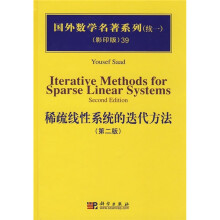Preface to the Second Edition
Preface to the First Edition
1 Background in Linear Algebra
1.1 Matrices
1.2 Square Matrices and Eigenvalues
1.3 Types of Matrices
1.4 Vector Inner Products and Norms
1.5 Matrix Norms
1.6 Subspaces, Range, and Kernel
1.7 Orthogonal Vectors and Subspaces
1.8 Canonical Forms of Matrices
1.8.1 Reduction to the Diagonal Form
1.8.2 The Jordan Canonical Form
1.8.3 The Schur Canonical Form
1.8.4 Application to Powers of Matrices
1.9 Normal and Hermitian Matrices
1.9.1 Normal Matrices
1.9.2 Hermitian Matrices
1.10 Nonnegative Matrices, M-Matrices
1.11 Positive Definite Matrices
1.12 Projection Operators
1.12.1 Range and Null Space of a Projector
1.12.2 Matrix Representations
1.12.3 Orthogonal and Oblique Projectors
1.12.4 Properties of Orthogonal Projectors
1.13 Basic Concepts in Linear Systems
1.13.1 Existence of a Solution
1.13.2 Perturbation Analysis
Exercises
Notes and References
2 Discretization of Partial Differential Equations
2.1 Partial Differential Equations
2.1.1 Elliptic Operators
2.1.2 The Convection Diffusion Equation
2.2 Finite Difference Methods
2.2.1 Basic Approximations
2.2.2 Difference Schemes for the Laplacian Operator
2.2.3 Finite Differences for One-Dimensional Problerr
2.2.4 Upwind Schemes
2.2.5 Finite Differences for Two-Dimensional Problerr
2.2.6 Fast Poisson Solvers
2.3 The Finite Element Method
2.4 Mesh Generation and Refinement
2.5 Finite Volume Method
Exercises
Notes and References
3 Sparse Matrices
3.1 Introduction
3.2 Graph Representations
3.2.1 Graphs and Adjacency Graphs
3.2.2 Graphs of PDE Matrices
3.3 Permutations and Reorderings
3.3.1 Basic Concepts
3.3.2 Relations with the Adjacency Graph
3.3.3 Common Reorderings
3.3.4 Irreducibility
3.4 Storage Schemes
3.5 Basic Sparse Matrix Operations
3.6 Sparse Direct Solution Methods
3.6.1 MD Ordering
3.6.2 ND Ordering
3.7 Test Problems
Exercises
Notes and References
4 Basic Iterative Methods
4.1 Jacobi, Gauss-Seidel, and Successive Overrelaxation
4.1.1 Block Relaxation Schemes
4.1.2 Iteration Matrices and Preconditioning
4.2 Convergence
4.2.1 General Convergence Result
4.2.2 Regular Splittings
4.2.3 Diagonally Dominant Matrices
4.2.4 Symmetric Positive Definite Matrices
4.2.5 Property A and Consistent Orderings
4.3 Alternating Direction Methods
Exercises
Notes and References
5 Projection Methods
5.1 Basic Definitions and Algorithms
5.1.1 General Projection Methods
5.1.2 Matrix Representation
5.2 General Theory
5.2.1 Two Optimality Results
5.2.2 Interpretation in Terms of Projectors
5.2.3 General Error Bound
5.3 One-Dimensional Projection Processes
5.3.1 Steepest Descent
5.3.2MR Iteration
5.3.3 Residual Norm Steepest Descent
5.4 Additive and Multiplicative Processes
Exercises
Notes and References
6 Kryiov Subspace Methods, Part I
6.1 Introduction
6.2 Krylov Subspaces
6.3 Arnoldis Method
6.3.1 The Basic Algorithm
6.3.2 Practical Implementations
6.4 Arnoldis Method for Linear Systems
6.4.1 Variation 1: Restarted FOM
6.4.2Variation 2: IOM and DIOM
6.5 Generalized Minimal Residual Method
6.5.1 The Basic GMRES Algorithm
6.5.2 The Householder Version
6.5.3 Practical Implementation Issues
6.5.4 Breakdown of GMRES
6.5.5 Variation 1: Restarting
6.5.6 Variation 2: Truncated GMRES Versions
6.5.7 Relations Between FOM and GMRES
6.5.8 Residual Smoothing
6.5.9 GMRES for Complex Systems
6.6 The Symmetric Lanczos Algorithm
6.6.1 The Algorithm
6.6.2 Relation to Orthogonal Polynomials
6.7 The Conjugate Gradient Algorithm
6.7.1 Derivation and Theory "
6.7.2 Alternative Formulations
6.7.3 Eigenvalue Estimates from the CG Coefficients
6.8 The Conjugate Residual Method
6.9 Generalized Conjugate Residual, ORTHOMIN, and ORTHODIR
6.10 The Faber-Manteuffel Theorem
6.11 Convergence Analysis
6.11.1 Real Chebyshev Polynomials
6.11.2 Complex Chebyshev Polynomials
6.11.3 Convergence of the CG Algorithm
6.11.4 Convergence of GMRES
6.12 Block Krylov Methods
Exercises
Notes and References
7 Kryiov Subspaee Methods, Part II
7.1 Lanczos Biorthogonalization
7.1.1 The Algorithm
7.1.2 Practical Implementations
7.2 The Lanczos Algorithm for Linear Systems
7.3 The Biconjugate Gradient and Quasi-Minimal Residual Algorithms
7.3.1 The BCG Algorithm
7.3.2 QMR Algorithm
7.4 Transpose-Free Variants
7.4.1 CGS
7.4.2 BICGSTAB
7.4.3 TFQMR
Exercises
Notes and References
8 Methods Related to the Normal Equations
8.1 The Normal Equations
8.2 Row Projection Methods
8.2.1 Gauss-Seidel on the Normal Equations
8.2.2 Cimminos Method
8.3 Conjugate Gradient and Normal Equations
8.3.1 CGNR
8.3.2 CGNE
8.4 Saddle-Point Problems
Exercises
Notes and References
9 Preconditioned Iterations
9.1 Introduction
9.2 Preconditioned Conjugate Gradient
9.2.1 Preserving Symmetry
9.2.2 Efficient Implementations
……
10 Preconditioning Techniques
11 Parallel Implementations
12 Parallel Preconditioners
13 Multigrid Methods
14 Domain Decomposition Methods
Bibliography
Index

 缺书网
缺书网 扫码进群
扫码进群



